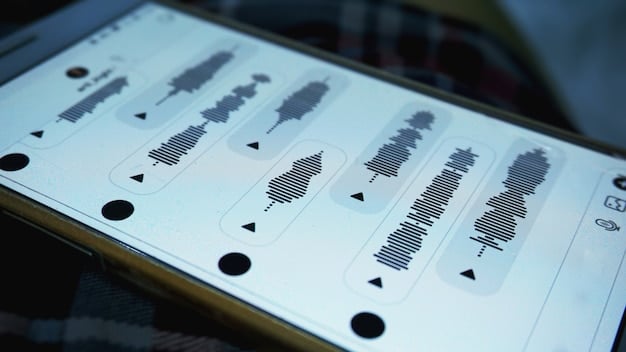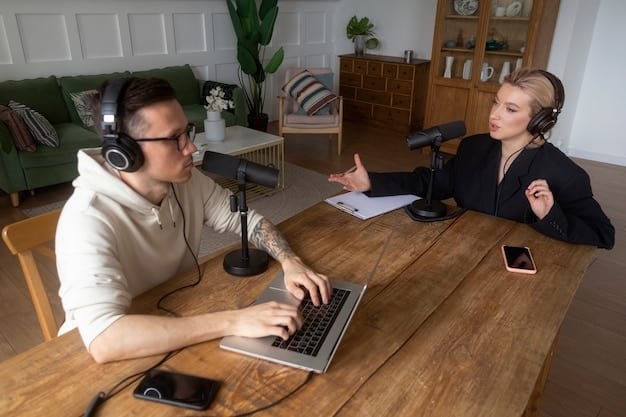Is Your Music Streaming Royalty Rate Fair? 2025 US Standard Explained

Understanding music streaming royalty rates is crucial for artists. This article delves into the 2025 US standard, factors influencing these rates, and how musicians can negotiate for fairer compensation in the evolving digital music landscape.
Are you a musician wondering whether you’re being fairly compensated for your music on streaming platforms? Navigating the world of music streaming royalties can be complex, but understanding the key factors and the upcoming 2025 US standard is essential. Let’s explore if your music streaming royalty rate is fair and how you can negotiate for better terms.
Understanding Music Streaming Royalty Rates: The Basics
Music streaming has revolutionized the music industry, offering artists unprecedented reach. However, it has also brought complexities regarding compensation. Understanding how music streaming royalty rates are calculated is the first step in determining whether you’re receiving a fair share.
How Streaming Services Calculate Royalties
Streaming services like Spotify, Apple Music, and Amazon Music use complex algorithms to determine royalty payments. These calculations often involve factors like the number of streams, the subscriber base, and the geographical location of listeners.
Typically, royalties are not paid per stream but rather from a pool of revenue generated from subscriptions and advertising. This pool is then divided among rights holders based on their share of total streams.
- Pro Rata Model: This is the most common model, where royalties are distributed based on an artist’s proportion of total streams.
- User-Centric Model: A more artist-friendly model where royalties are distributed based on each user’s listening habits, potentially benefiting niche artists.
- Direct Licensing: Some artists and labels negotiate direct licensing agreements with streaming services for potentially higher royalty rates.
Understanding these models helps artists anticipate their earnings and assess the fairness of their existing agreements.
In conclusion, grasping the basics of how streaming royalties are calculated allows artists to make informed decisions and advocate for fairer compensation.
The 2025 US Standard: What to Expect
The music industry is continually evolving, and with it come changes to royalty structures. The 2025 US standard for music streaming royalties is poised to introduce significant updates that could affect artists’ earnings. Staying informed about these changes is crucial for planning your financial future.
Key Changes in the 2025 Standard
The proposed 2025 standard is expected to bring greater transparency and standardization to royalty calculations. This may include clearer definitions of what constitutes a stream and more detailed reporting on how royalties are allocated.
Additionally, there’s a push to address some of the long-standing issues with the pro rata model, potentially moving towards more equitable distribution methods that favor smaller artists and independent labels.

- Increased Transparency: More detailed breakdowns of how royalties are calculated.
- Standardized Definitions: Clearer guidelines on what constitutes a legitimate stream.
- Equitable Distribution: Potential shifts towards user-centric or hybrid royalty models.
These changes aim to create a more sustainable ecosystem for artists, ensuring they receive compensation that reflects the value of their work.
In summary, the 2025 US standard represents a significant step towards modernizing music streaming royalties, with a focus on fairness and transparency.
Factors Influencing Your Royalty Rate
Several factors can influence your music streaming royalty rate, and understanding these can empower you to negotiate more effectively. From label agreements to the type of listener, many variables play a role in determining your earnings.
Understanding the Variables
One of the primary factors is your agreement with your record label or distributor. The percentage split negotiated in these contracts significantly impacts how much of the revenue you ultimately receive.
Additionally, the type of listener (premium subscriber vs. free user) can affect the royalty rate, as premium subscribers generate more revenue per stream. The geographical location of your listeners also matters, as royalty rates vary by country.
- Label Agreements: Negotiate favorable terms to maximize your share of royalties.
- Type of Listener: Premium subscribers generally contribute more to royalty pools.
- Geographical Location: Royalty rates differ based on the listener’s country.
Taking these factors into account can help you evaluate your current royalty rate and identify areas for potential improvement.
In conclusion, being aware of the various factors influencing your royalty rate allows you to make informed decisions and advocate for fairer compensation.
Negotiating for a Fairer Royalty Rate
Negotiating a fairer royalty rate can be a challenging but essential part of being a successful musician. Knowing your worth and understanding the leverage you have can significantly increase your earnings from streaming.
Strategies for Successful Negotiation
Before entering negotiations, research industry standards and benchmarks for artists in your genre and career stage. Having this data will support your case and demonstrate that your demands are reasonable.
Another effective strategy is to build a strong negotiating team, including a knowledgeable entertainment lawyer and a business manager who can advocate on your behalf.

- Do Your Research: Understand industry standards and benchmarks.
- Build a Team: Enlist the help of experienced lawyers and managers.
- Know Your Worth: Highlight your unique value and audience reach.
Focus on the long-term value you bring to the platform, such as your loyal fanbase and potential for growth. Demonstrating your worth can justify a higher royalty rate.
To summarize, successful negotiation requires preparation, a strong team, and a clear understanding of your value in the streaming ecosystem.
The Role of Collective Bargaining and Unions
Collective bargaining and unions play a crucial role in advocating for artists’ rights and fairer compensation in the music industry. Joining or supporting these organizations can provide significant leverage in negotiating royalty rates.
Understanding Collective Action
Collective bargaining allows musicians to pool their resources and negotiate with streaming platforms as a unified group. This gives them more power than individual artists negotiating alone.
Unions also provide legal support, education, and resources to help artists understand their rights and navigate the complexities of the music industry.
- Pooled Resources: Musicians gain strength through collective action.
- Legal Support: Unions provide essential legal assistance and education.
- Industry Advocacy: Unions actively fight for fairer industry practices.
By participating in collective action, artists can collectively demand fairer royalty rates and better working conditions.
In conclusion, collective bargaining and unions are powerful tools for artists seeking fairer compensation and greater control over their careers.
Alternative Revenue Streams for Musicians
While streaming royalties are important, relying solely on them for income can be precarious. Exploring alternative revenue streams can provide financial stability and diversify your earnings.
Exploring Additional Options
One popular option is direct fan engagement through platforms like Patreon or Bandcamp, where fans can directly support artists through subscriptions or merchandise purchases. These platforms often provide a higher percentage of revenue compared to streaming services.
Additionally, live performances, merchandise sales, and licensing your music for film, television, or advertising can generate significant income.
- Direct Fan Engagement: Platforms like Patreon and Bandcamp connect artists with their supporters.
- Live Performances: Concerts and shows provide a substantial source of income.
- Licensing: Selling your music for use in other media can be lucrative.
Diversifying your income streams reduces your dependence on streaming royalties and ensures a more sustainable career.
To summarize, exploring alternative revenue streams empowers musicians to take control of their financial future and reduce reliance on streaming royalties.
Future Trends in Music Streaming Royalties
The landscape of music streaming royalties is continuously changing, influenced by technological advancements and shifts in consumer behavior. Staying ahead of these trends is essential for artists to adapt and thrive.
Technological and Industry Shifts
One emerging trend is the use of blockchain technology to create more transparent and efficient royalty distribution systems. Blockchain can track streams in real-time and ensure that royalties are accurately allocated to rights holders.
Another trend is the increasing personalization of music experiences, with streaming services using artificial intelligence to curate playlists and recommend new music to listeners. This could lead to changes in how royalties are allocated based on listener engagement.
- Blockchain Technology: Provides transparency and efficiency in royalty distribution.
- AI Personalization: Influences how royalties are allocated based on listener engagement.
- Virtual Reality and Metaverse: New platforms for artists to monetize their music.
Additionally, the rise of virtual reality and the metaverse presents new opportunities for artists to monetize their music through virtual concerts and immersive experiences.
In conclusion, understanding these future trends allows musicians to prepare for the evolving landscape of music streaming royalties and capitalize on new opportunities.
| Key Point | Brief Description |
|---|---|
| 💰 Royalty Basics | Understanding how streaming services calculate and distribute royalties. |
| ⚖️ 2025 Standard | Key changes and potential impacts of the 2025 US royalty standard. |
| 📈 Negotiation | Strategies for negotiating fairer royalty rates with streaming platforms. |
| 🤝 Collective Action | The role of unions and collective bargaining in securing better royalties. |
FAQ
▼
Music streaming royalties are calculated based on a complex formula involving the pro rata model, where a percentage of the platform’s total revenue is distributed among artists based on their share of total streams.
▼
The 2025 US standard aims to bring greater transparency and standardization to royalty calculations, potentially shifting toward more equitable distribution methods that support smaller artists and independent labels.
▼
Your royalty rate is influenced by factors such as your label agreement, the type of listener (premium vs. free), the geographical location of listeners, and any direct licensing agreements you may have.
▼
To negotiate a fairer rate, research industry standards, build a strong negotiating team, and highlight your unique value and audience reach to justify higher compensation from streaming platforms.
▼
Musicians can explore alternative revenue streams such as direct fan engagement via platforms like Patreon, live performances, merchandise sales, and licensing their music for various media projects to diversify their income.
Conclusion
Navigating the intricacies of music streaming royalties requires a comprehensive understanding of current standards, negotiation strategies, and alternative income streams. By staying informed and proactive, musicians can advocate for fair compensation and build sustainable careers in the evolving digital music landscape.





